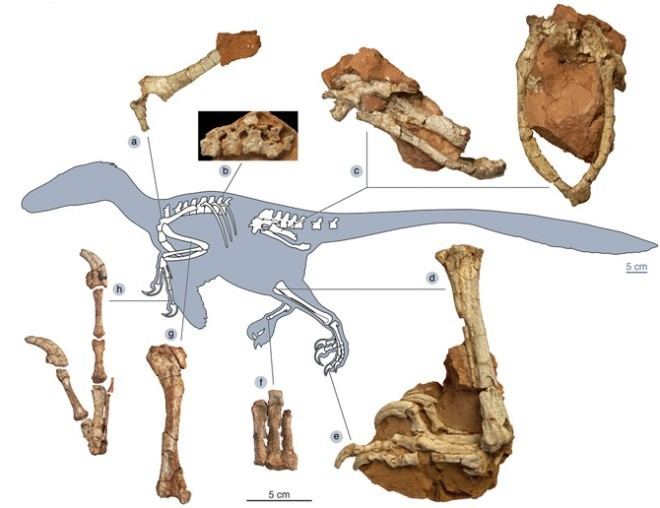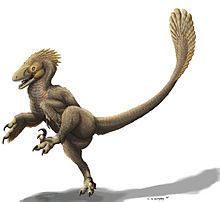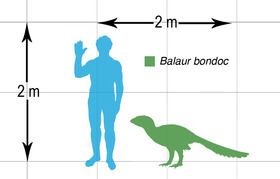Rank Species | Class Reptilia Phylum Chordata | |
 | ||
Genus †BalaurCsiki et al., 2010 Similar Dromaeosauridae, Magyarosaurus, Concavenator, Adasaurus, Telmatosaurus | ||
Balaur bondoc is a species of theropod dinosaur which lived in what is now Romania during the late Cretaceous period. It is the type species of the monotypic genus Balaur which was described by scientists in August 2010, and was named after the balaur ([baˈla.ur]), a dragon of Romanian folklore. The specific name bondoc means "stocky", so Balaur bondoc means "stocky dragon" in Romanian. This name refers to the greater musculature that Balaur had compared to its relatives. The genus is known from two partial skeletons including the type specimen.
Contents
- Machet de balaur bondoc n m rime natural
- DescriptionEdit
- Discovery and namingEdit
- ClassificationEdit
- Diet and lifestyleEdit
- Island effectsEdit
- References

Seventy million years ago, world sea levels were higher, and the location where its fossils are found was a part of the European Archipelago called Hațeg Island which is also referred to as the "Island of the Dwarf Dinosaurs". Unlike other early members of the group Paraves, which includes Velociraptor, Troodon, and Archaeopteryx, this theropod had not just one but two large, retractable, sickle-shaped claws on each foot, and its limbs were proportionally shorter and heavier than those of its relatives. As with other dinosaurs from Hațeg, such as Magyarosaurus, a dwarf sauropod, its strange features have been argued to show the effects of its island habitat on its evolution.

Machet de balaur bondoc n m rime natural
DescriptionEdit

Balaur is a genus of theropod dinosaurs estimated to have lived about 70 million years ago in the late Cretaceous (Maastrichtian), and contains the single species B. bondoc. The bones of this species were shorter and heavier than those of other basal paravians. While the feet of most early paravians bore a single, large "sickle claw" on the second toe which was held retracted off the ground, Balaur had large retractable sickle claws on both the first and second toes of each foot. In addition to its strange feet, the type specimen of Balaur is unique for its status of being the most complete theropod fossil from the late Cretaceous of Europe. It also possesses a great number of additional autapomorphies, including a reduced and presumably nonfunctional third finger, consisting of only one rudimentary phalanx.
The partial skeleton was collected from the red floodplain mudstone of the Sebeș Formation of Romania. It consists of a variety of vertebrae, as well as much of pectoral and pelvic girdles, and a large part of the limbs. It is the first reasonably complete and well-preserved theropod from the Late Cretaceous of Europe.
It is similar in size to Velociraptor, with Balaur's recovered skeletal elements suggesting an overall length of around 1.8–2.1 metres (5.9–6.9 ft). Balaur had re-evolved a functional first toe used to support its weight, which bore a large claw that could be hyperextended. It had short and stocky feet and legs, and large muscle attachment areas on the pelvis which indicate that it was adapted for strength rather than speed. Csiki et al. describe this "novel body plan" as "a dramatic example of aberrant morphology developed in island-dwelling taxa." The stocky feet are exemplified by the length of the metatarsus being only two times its width. It is 1.5 times wider than the lower leg. Both traits are unique in the Theropoda. The skeleton of Balaur also shows extensive fusion of limb bones. Wrist bones and the metacarpals are fused into a carpometacarpus. The pelvic bones are fused. The shinbone, calf bone and the upper ankle bones have been fused into a tibiotarsus and the lower ankle bones and the metatarsals into a tarsometatarsus. The degree of fusion is typical for the Avialae, the evolutionary branch of the birds and their direct relatives.
Discovery and namingEdit
The first small bones belonging to Balaur bondoc consisted of six elements of the front limbs. Named specimens FGGUB R. 1580–1585, these were discovered in 1997 in Romania by Dan Grigorescu, but the morphology of the arm was so unusual that scientists could not correctly combine them, mistaking them for the remains of an oviraptorosaur. The first partial skeleton was discovered in September 2009 in Romania, approximately 2.5 kilometers north of Sebeș, along the Sebeș river in the Sebeș Formation dating from the early Maastrichtian, and was given the preliminary field number SbG/A-Sk1. Later it received the holotype inventory number EME VP.313. The discovery was made by the geologist and paleontologist Mátyás Vremir of the Transylvanian Museum Society of Cluj Napoca who sent them for analysis to Zoltán Csiki of the University of Bucharest. The findings were described on August 31, 2010, in the Proceedings of the National Academy of Sciences. The 1997 specimens indicate an individual about 45% longer than the holotype; they were also found in a younger stratum.
The generic name Balaur (three syllables, stressed on the second /a/) is from the Romanian word for a dragon of Romanian folklore, while the specific epithet bondoc (pronounced like "boned oak", meaning "a squat, chubby individual") refers to the small, robust shape of the animal. As the balaur is a winged dragon, the name additionally hints at the close relation of Balaur to the birds within Panaves. Bondoc was chosen by the discoverers also because it is derived from the Turkish bunduk, "small ball", thus alluding to the probable Asian origin of the ancestors of Balaur.
ClassificationEdit
The position of Balaur relative to other bird-like dinosaurs and early birds has been difficult to determine. The initial phylogenetic analysis placed Balaur bondoc closest to the Asiatic mainland dromaeosaurid species Velociraptor mongoliensis. A 2013 study by Brusatte and colleagues, using a modified version of the same data, found it in an unresolved close relationship with the dromaeosaurids Deinonychus and Adasaurus, with some possible alternative trees suggesting it branched off before the common ancestor of Deinonychus and Velociraptor, while others maintained it as the closest relative of Velociraptor, with Adasaurus as their next closest relative.
More recent analyses using different sets of anatomical data have since cast doubt on a dromaeosaurid classification for Balaur. In 2013, a larger analysis containing a wide variety of coelurosaurs found that Balaur was not a dromaeosaurid at all, but a basal avialan, more closely related to modern birds than to Jeholornithiformes but more basal than Omnivoropterygiformes. A study published in 2014 found Balaur to be sister to Pygostylia. An independent analysis using an expanded version of the original data set (the one that found Balaur to be a dromaeosaurid) drew a similar conclusion in 2014. In 2015, researchers Andrea Cau, Tom Brougham, and Darren Naish published a study which specifically attempted to clarify which theropods were close relatives of Balaur. While their analysis could not completely rule out the possibility that B. bondoc was a dromaeosaurid, they concluded that this result was less likely than the classification of Balaur as a non-pygostylian avialan based on several important bird-like features. Many of the presumed unique traits would in fact have been normal for a member of the Avialae. Typical bird features included the degree of fusion of the limb bones, the functional first toe, the first toe claw not being smaller than the second claw, a long penultimate phalanx of the third toe, a small fourth toe claw and a long fifth metatarsal.
Diet and lifestyleEdit
Little is known about the behavior of Balaur. Because of the lack of skull material, it is impossible to determine by the shape of the teeth whether Balaur was a carnivore or a herbivore. The original description assumed it was carnivorous because it had been found that it was closely related to Velociraptor. Csiki speculated in 2010 that it may have been one of the apex predators in its limited island ecosystem, because of larger theropods not even the teeth have ever been found in Romania. He also believed that it likely used its double sickle claws for slashing prey, and that the atrophied state of its hands indicates that it probably did not use them to hunt. One of the original discoverers indicated that it "was probably more of a kickboxer than a sprinter" compared to Velociraptor, and was probably able to hunt larger animals than itself. However, more recent studies by Denver Fowler and others have shown that the foot anatomy of paravians like Balaur indicate that they used their large claws to grip and pin prey to the ground while flapping with their proto-wings to stay on top of their victim. Once it was worn out, they might have proceeded to feast while it was still alive as some modern birds of prey still do. Due to the shape of the claws, they would not have been effective in slashing attacks. The very short, fused metatarsus of Balaur and enlarged first claw, strange even by dromaeosaur standards, are thought to be consistent with these newer studies, lending further support to the idea that Balaur was a predator.
Italian paleontologist Andrea Cau has speculated that the aberrant features present in Balaur may have been a result of this theropod being omnivorous or herbivorous rather than carnivorous like most non-avian theropods. The lack of the third finger may be a sign of reduced predatory behavior, and the robust first toe could be interpreted as a weight-supporting adaptation rather than a weapon. These characteristics are consistent with the relatively short, stocky limbs and wide, swept-back pubis, which may indicate enlarged intestines for digesting vegetation as well as reduced speed. Cau referred to this as the "Dodoraptor" model. However, in light of the research done by Fowler et al., Cau has remarked that the anatomy of Balaur may be more congruent with the hypothesis that Balaur was predatory after all.
In 2015, Cau et al. reconsidered the ecology of Balaur again in their reevaluation of its phylogenetic position, arguing that if Balaur was an avialan, it would be phylogenetically bracketed by taxa known to have been herbivorous, such as Sapeornis and Jeholornis. This suggests a non-hypercarnivorous lifestyle to be a more parsimonious conclusion and supports Cau's initial interpretations of its specializations. This is also indicated by the reduced third finger, the lack of a gynglymoid lower articulation of the second metatarsal and the rather small and moderately recurved second toe claw. Balaur had a broad pelvis, a broad foot, a large first toe, and broad lower ends of the metatarsals relative to the articulation surfaces; such a combination can in the remainder of the Theropoda only be found with the herbivorous Therizinosauridae.
Island effectsEdit
During the Maastrichtian age, much of Europe was fragmented into islands, and a number of the bizarre features of Balaur are thought to be a result of an "island effect", the relatively isolated conditions imposed on many of the populations in this area. Species which are isolated on islands can be subject to the effects of genetic drift and the founder effect which can magnify the effect of mutations which might be diluted in a larger population. Other island effects such as Foster's rule, which describes how small mainland species become larger and large mainland species become smaller, can take effect. Cretaceous Romania is known, for example, for its dwarf sauropods. In 2010, this island effect was assumed to consist in rapid changes in a relatively recently arrived invading species and not seen as the result of an isolated development of an endemic form during tens of millions of years. The assumed close relationship to Velociraptor would have implied that the isolation of Haţeg Island must have been relative and intermittent.
In 2010, the increased robustness of Balaur was compared to parallel changes seen in isolated herbivorous mammals. In 2013, it was claimed that Balaur was the only vertebrate predatory island species known to have become more robust and it was suggested that its broad feet had evolved to improve stability. The 2015 interpretation of Balaur as an omnivorous member of the Avialae, suggested it was the descendant of a flying species that had developed a larger size similar to the development in several other island herbivores. This would then be a rare instance of secondary flightlessness in a paravian looking like a dromaeosaurid, as predicted by Gregory S. Paul.
